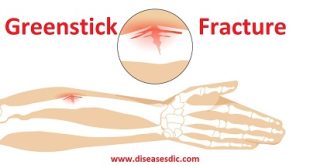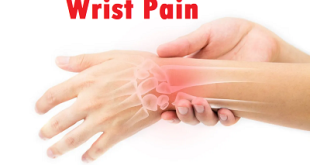Definition
Colles Fracture is a complete fracture of the radius bone of the forearm close to the wrist resulting in an upward (posterior) displacement of the radius and obvious deformity. It is commonly called a “broken wrist” although the distal radius is the location of the fracture, not the carpal bones of the wrist.
Fractures of the distal radius are extremely common and historically several methods of classification have been proposed. At present time in the United States, and for the purposes of this article, we will refer to all distal radius fractures as Colles Fractures. Smith fractures, Chauffer’s fractures, and Barton’s fractures- other types of distal radius fractures- are also included under the umbrella of distal radius fractures.
Distal radius fractures are further classified based on certain characteristics. A fracture of the distal radius can be intra- or extra-articular, depending on whether the fracture extends into the wrist joint. These intra- or extra-articular fractures can either be displaced or alignment can be maintained. When the distal radius is broken into many small pieces of bone as in a crush injury, it is deemed a comminuted fracture. Distal radius fractures can also pierce the skin resulting in an open fracture.
Epidemiology
It is known that these fractures appear mostly by young adults and the elderly and more often in females compared to males, often there is a history of osteoporosis. In the United States and in Northern Europe, Colles fractures are the most common fractures in women up to the age of 75 years. Stable Colles’ fractures present with minimal comminution. Unstable fractures are distinctly comminuted often with corresponding avulsions of the radial or ulnar styloid, that have the potential to cause compression neuropathies, especially of the median nerve. Other complications that have been reported are degenerative joint disease and reflex sympathetic dystrophy.
Colles fractures are the most common type of distal radial fracture and are seen in all adult age groups and demographics. They are particularly common in patients with osteoporosis, and as such, they are most frequently seen in elderly women and particularly from simply falling on an outstretched hand in a ground-level fall. The relationship between Colles fractures and osteoporosis is strong enough that when an older male patient presents with a Colles fracture, he should be investigated for osteoporosis because his risk of a hip fracture is also elevated. An increasing awareness of osteoporosis has led to these injuries being termed fragility fractures, with the implication that a workup for osteoporosis should be a standard part of treatment. As the population lives longer, the frequency of this type of fracture will increase.
Younger patients have stronger bone, and thus, more energy is required to create a fracture in these individuals. Younger patients who sustain Colles fractures have usually been involved in high impact trauma or have fallen, e.g., during contact sports, skiing, horse riding, motorcycle accidents, falls from a height.
Pathophysiology
The most common cause of Colles fractures is trauma. This usually relates to athletic injuries or motor vehicle accidents in younger patients. In the elderly population, this is most often caused by falls. When the traumatic force hits an outstretched hand, force is transmitted dorsally through the wrist, fracturing the distal radius, displacing it dorsally, and often causing dorsal comminution. This mechanism leads to the classic “dinner fork” deformity of the wrist with associated pain, edema, and decreased range of motion.
Distal radius fracture can be associated with multiple other injuries, such as distal radioulnar joint injury (DRUJ), Triangular fibrocartilage injury (TFCC), scapholunate, and lunotriquetral ligament injuries. An associated radial styloid fracture would indicate a high-energy mechanism of injury.
Types of colles fractures
- Intra-articular fracture – Articular means joint. This type of fracture affects the wrist joint entirely.
- Extra-articular fracture – A fracture that doesn’t reach out into the joint is called an extra-articular fracture.
- Open fracture – When a broken bone fractures the skin, it is called an open fracture.
- Comminuted fracture – When a bone is broken into multiple pieces, it is known as a comminuted fracture.
Open and comminuted fractures are harder to treat. They require surgical correction of the bone using plates and screws.
Causes of Colles Fracture
Colles fracture can occur due to various reasons like during a big trauma like a car accident or during a major fall. Some of the common causes are discussed below.
Osteoporosis
Colles fracture can occur when there is decreased bone density. The early signs and symptoms of osteoporosis may be the breakage of small bones.
When you have tender bones or the density of bones decrease, it is important to consult your healthcare provider. Distal radius fracture can also indicate that you are prone to Colles fracture.
Elderly prone to Colles fracture
Elderly people have weakened and softened bones. So, they are prone to Colles fracture. These fractures can occur when there is a replacement of bone in the wrist due to osteoporosis. However, these types of fractures will not lead to any type of functional impairments.
Have low muscle mass or poor muscle strength
Muscle weakness can lead to Colles fracture. Further muscle weakness can increase the risk of fractures and low bone mineral density.
Muscle weakness is linked to premature mortality in the general population, according to studies that appeared in the Journal of Bone and Mineral Research. However, those who have comorbid conditions are more vulnerable to this kind of mortality.
Colles Fracture Symptoms
Symptoms of a broken wrist can include:
- Pain, especially when flexing the wrist
- Tenderness
- Swelling
- Bruising
- Deformity of the wrist, sometimes called a “dinner fork deformity,” which causes it to look crooked and bent.
To diagnose a broken wrist, your doctor will give you a thorough physical exam. You may need several sets of X-rays, since the fracture may be hard to see at first.
Occasionally, a broken wrist can affect the nerves or blood flow. You should go to the emergency room if:
- Your wrist is in great pain.
- Your wrist, arm, or hand is numb.
- Your fingers are pale.
Complications
Patients frequently heal well with no complications at all. If redisplacement of the Colles fracture is seen a few cases week after reduction, it’s important to take and check radiographs a week-10 days after injury. Possible complications include:
- Malunion
- Persistent translation of the carpus
- Shortening of radius
- Stiffness of the wrist and the forearm
Few very rare complications are carpal tunnel syndrome, Sudeck’s atrophy and ulnar and radial compression neuropathy.
Risk factors
The main risk factors for distal radius fractures are related to osteoporosis:
- Increasing age
- Female gender
- Early menopause
- Smoking or alcohol excess
- Prolonged steroid use
Diagnosis
Diagnosis of a Colles fracture will normally be done by your doctor when you present the injury. The diagnosis will be supported by the use of X-ray or MRI, which will confirm the presence and severity of the fracture.
X-rays
X-rays help to see the broken bone and whether the broken bone is displaced or not. It also shows if there are any pieces of a broken bone.
Computed tomography scan (CT scan)
CT scans show injuries to soft tissues and blood vessels
Magnetic resonance imaging (MRI)
MRI shows detailed images of bone and soft tissues and also identify very small fracture, nerve, tendon, and ligament injuries when the wrist is broken
Treatment for Colles Fracture
Treatment of Colles fractures depend on the type of Colles fracture present, the age and activity level of the patient, the surgeon’s preference in treatment method, and the patient’ s desires regarding immobilization and return to activity. As Colles fractures are so common, many methods of treatment have been developed to stabilize the fractures and allow the bone to heal. The goal is to return the wrist to its prior level of functioning.
Non-surgically
If the fracture is not displaced and pain is minimal, a simple splint may be used to immobilize the area. This method is most frequently employed in elderly, low activity level patients. In young, active patients a plaster cast is usually placed to ensure immobilization and proper healing.
If the fracture is minimally displaced, the surgeon may manually move the bones back in place in a procedure called closed reduction. This is followed by a plaster cast for 6 weeks during which time x rays are taken periodically to ensure the bone remains aligned.
Surgical Treatment
Sometimes, the position of the bone cannot be corrected with a closed reduction alone and/or cannot or kept corrected in a cast. These fractures may heal in bad alignment, which can result in poor function of your arm. In such cases, you may require surgery to correct the fracture and hold it in place while it heals.
Procedure. Surgery typically involves making an incision on the wrist over the fracture to access the broken bone(s). Important structures such as arteries, nerves, and tendons are identified and protected. The surgeon realigns the broken bone(s) directly through the incision. This process is also known as an open reduction.
Cast for Colles Fracture
Depending on the fracture, there are several options for holding the bone in the correct position while it heals after it has been re-aligned:
- Cast — Casts are rarely used after an open reduction.
- Metal pins (usually stainless steel or titanium) — This treatment was common years ago and is still used frequently in children with growing bones.
- Plate and screws — This is the most common option for surgical treatment of distal radius fractures.
- External fixator (a stabilizing frame outside the body that holds the bones in the proper position so they can heal) — This has become less common in recent years but is still a good option for severe and open fractures.
- Any combination of these techniques
Prevention of Colles Fracture
Preventing a Colles fracture might not be possible, but you can take certain safety precautions to lower your risk of injury, including:
- Wear a wrist guard when you skate.
- Wear wrist armor when you’re on a motorcycle.
- Stay off ladders and avoid other heights.
- Rearrange your home so that there’s nothing to trip over like rugs or small tables.
Falls aren’t always preventable. Do what you can to protect yourself.
 Diseases Treatments Dictionary This is complete solution to read all diseases treatments Which covers Prevention, Causes, Symptoms, Medical Terms, Drugs, Prescription, Natural Remedies with cures and Treatments. Most of the common diseases were listed in names, split with categories.
Diseases Treatments Dictionary This is complete solution to read all diseases treatments Which covers Prevention, Causes, Symptoms, Medical Terms, Drugs, Prescription, Natural Remedies with cures and Treatments. Most of the common diseases were listed in names, split with categories.







